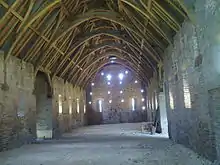Tithe Barn, Pilton
The Tithe Barn at Cumhill Farm in Pilton, Somerset, England, was built in the 14th century as a tithe barn to hold produce for Glastonbury Abbey. It is a Grade I listed building and Scheduled Ancient Monument.[1]
| Tithe Barn | |
|---|---|
 | |
 Location within Somerset | |
| General information | |
| Town or city | Pilton, Somerset |
| Country | England |
| Coordinates | 51.1634°N 2.5891°W |
| Completed | 14th century |
| Client | Glastonbury Abbey |
The barn, of coursed and squared rubble,[1] was originally built in the 14th and 15th centuries to hold the produce from farms in the area who paid one tenth of their produce to Glastonbury Abbey as the landowner. It is one of four surviving monastic barns built by the Abbey,[2] the others being the Tithe Barn, Manor Farm, Doulting, the West Pennard Court Barn and the Glastonbury tithe barn, now the Somerset Rural Life Museum.
Restoration
On 9 June 1963 lightning set fire to the thatched roof[3] and it remained a wreck until Michael Eavis, organiser of the Glastonbury Festival, bought it in 1995,[2] and presented the barn to the Pilton Barn Trust.
The project was made possible with a grant of £400,000 from English Heritage. The Glastonbury festival contributed a further £100,000.[4][5]
A new roof, replicating the original, using a combination of traditional carpentry techniques and modern technology,[3] has been built, by Peter McCurdy[3] using skills used when recreating the Globe theatre in London, from English oak which came from Northumberland.[3] The roof frame consists of cruck construction which sits high in the walls with an arcade plate then carrying the apex of the roof above.
McCurdy was also assisted by a local team run by Jon Maine[6][7] who designed and erected the complex scaffolding both internally and externally and then using 8000 36" long oak hand split (riven) battens tiled the roof using over 30,000 hand made plain tiles.
In addition to the new roof a new floor was laid, including a 3 metres (10 ft) wide strip in Blue Lias Stone and 44 cubic meters of lime concrete used to fill the expanses either side. It is said to be the largest expanse of lime concrete flooring anywhere in Europe.[8]
The restoration was nominated for the annual Wood Awards,[9] which recognise and encourage outstanding design, craftmanship and installation in joinery and structures in wood. It was awarded the prize as the Best Use of British Timber Award and Structural Timber Award in 2005. It also received the Royal Institute of British Architects Town and Country Design Award in the same year.[2]
It was officially opened on Friday 1 April 2005 by local historian Sir John Keegan and is now used for public events such as medieval fairs, dances, weddings, parties, Somerset Arts Week and village events.[3]

References
- Historic England. "Former Tithe Barn in farmyard at Cumhill Farm (1058842)". National Heritage List for England. Retrieved 2 November 2008.
- "Case Study – Pilton Barn" (PDF). Caroe & Partners Architects. Archived from the original (PDF) on 19 July 2011. Retrieved 2 November 2008.
- "Pilton Tithe Barn shortlisted for Wood Awards". BBC Somerset. BBC. Retrieved 2 November 2008.
- "Michael Eavis talks". BBC Somerset. BBC. Retrieved 2 November 2008.
- "12th Century Tithe Barn Restored with the Help of the Festival". Glastonbury Festival. 29 April 2009. Archived from the original on 4 December 2008. Retrieved 2 November 2008.
- Maine has recently saved Grade 2* Merchants House in Shepton Mallet
- "Archived copy". Archived from the original on 23 September 2017. Retrieved 4 May 2019.CS1 maint: archived copy as title (link)
- "Pilton Tithe Barn". Carrek. Archived from the original on 23 July 2011. Retrieved 2 November 2008.
- "Home". Wood Awards.
External links
 Media related to Tithe Barn, Pilton at Wikimedia Commons
Media related to Tithe Barn, Pilton at Wikimedia Commons